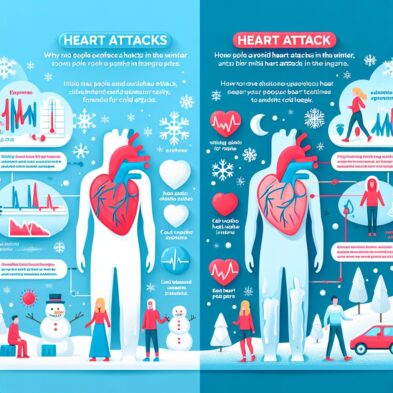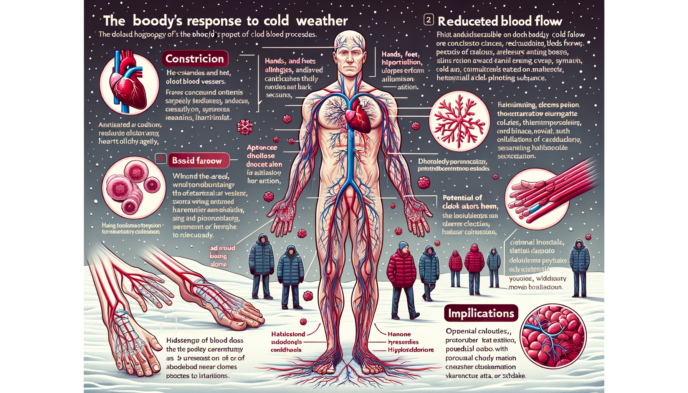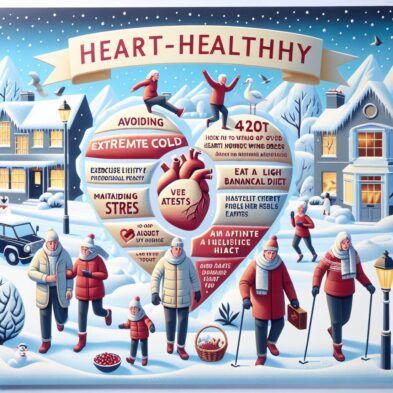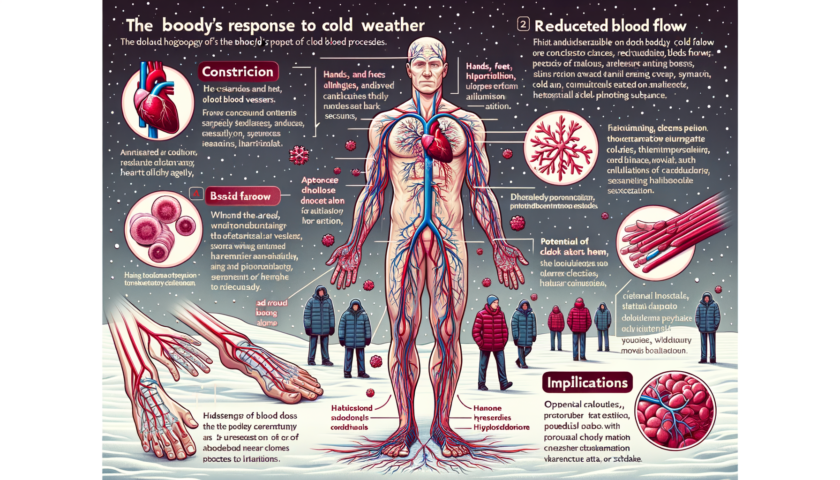Table of Contents
- Introduction
- The Impact of Cold Weather on the Heart
- 1. Constriction of Blood Vessels
- 2. Increased Blood Clotting
- 3. Physical Exertion
- Preventing Heart Attacks in Winters
- 1. Dress Appropriately
- 2. Stay Active
- 3. Manage Stress
- 4. Eat a Heart-Healthy Diet
- 5. Keep Warm Indoors
- Case Studies and Statistics
- Summary
Introduction
Winter is a season that brings joy and excitement for many, but it also poses certain health risks, especially for individuals with heart conditions. Studies have shown that there is a significant increase in the number of heart attacks during the winter months. This article aims to explore the reasons behind this phenomenon and provide valuable insights on how to avoid heart attacks in winters and save lives.
The Impact of Cold Weather on the Heart
Cold weather can have a profound impact on the cardiovascular system, increasing the risk of heart attacks. Here are some key factors that contribute to this:

1. Constriction of Blood Vessels
In colder temperatures, blood vessels tend to constrict, reducing blood flow to the heart. This constriction can lead to an increase in blood pressure and strain on the heart, making it more susceptible to a heart attack.
In colder temperatures, when the surrounding environment becomes chilly, our body’s natural response is to preserve heat and maintain its core temperature. One of the ways our body accomplishes this is by constricting blood vessels, particularly those located near the skin’s surface. However, this natural mechanism, while serving its purpose, can have unintended consequences on our cardiovascular system.
As the blood vessels constrict, their diameter narrows, which restricts the flow of blood throughout the body. This reduction in blood flow affects various organs and tissues, including the heart. The heart, being a vital organ responsible for pumping oxygen-rich blood throughout the body, requires a consistent and sufficient blood supply to function optimally.
When blood flow to the heart is hindered due to the constriction of blood vessels, the heart may not receive an adequate amount of oxygen and nutrients. This deficiency can lead to an increase in blood pressure, as the heart has to work harder to compensate for the reduced blood flow. The strain placed on the heart due to elevated blood pressure can gradually lead to the development of cardiovascular problems, such as hypertension or even heart attacks.
Furthermore, the reduced blood flow and subsequent increase in blood pressure can also influence the formation of blood clots. Blood clots are more likely to form when blood flow is sluggish or impeded, particularly in the narrowed blood vessels. If a blood clot forms and blocks a coronary artery, one of the blood vessels responsible for supplying oxygen to the heart muscle, it can result in a heart attack.
It is important to acknowledge that individuals already predisposed to cardiovascular issues, such as those with pre-existing heart conditions or high cholesterol, may be even more susceptible to the adverse effects of constricted blood vessels in colder temperatures. Therefore, it becomes crucial to take extra precautions and prioritize heart health during colder weather, such as staying warm, layering clothing, and avoiding prolonged exposure to cold environments.
By understanding the potential consequences of blood vessel constriction in colder temperatures, we can be proactive in safeguarding our cardiovascular health. Regular exercise, a healthy diet, and consulting with healthcare professionals can aid in maintaining optimal heart function, reducing the risk of heart-related complications in cold weather conditions.
2. Increased Blood Clotting
Cold weather promotes the formation of blood clots, which can block the arteries and cause a heart attack. The body’s natural response to cold temperatures is to constrict blood vessels, but this can also increase the risk of clot formation.

Cold weather promotes the formation of blood clots due to its impact on the body’s physiology. When exposed to low temperatures, the body instinctively tries to conserve heat by constricting blood vessels, particularly those in the extremities. This constriction, while beneficial in preserving core body temperature, can inadvertently lead to an increased risk of clot formation.
The constriction of blood vessels in response to cold temperatures reduces blood flow to certain areas of the body, particularly the hands, feet, and limbs. As a result, blood circulation slows down, creating an environment where blood cells may become stagnant. When blood flow becomes sluggish, platelets, which are responsible for clotting, can aggregate more easily, potentially leading to the formation of blood clots.
Furthermore, the reduced blood flow caused by vasoconstriction can also result in the accumulation of other clot-promoting substances. For instance, clotting factors and proteins, which are usually evenly distributed throughout the bloodstream, can accumulate in specific areas where blood flow is compromised. This localized accumulation further enhances the likelihood of clot formation.
Once a blood clot forms, it may obstruct blood vessels, impeding the normal flow of blood. If a clot lodges in a coronary artery supplying the heart, it can cause a blockage, resulting in a heart attack. Similarly, if a clot obstructs an artery that supplies blood to the brain, it can lead to a stroke.
It is worth noting that individuals with pre-existing medical conditions, such as atherosclerosis (narrowing of the arteries), hypertension (high blood pressure), or hyperlipidemia (high cholesterol levels), may be at an even higher risk of developing blood clots in cold weather. Moreover, prolonged exposure to cold temperatures without adequate protection can further exacerbate the risk.
To mitigate the effects of cold weather on blood clot formation, it is essential to take precautionary measures. Wearing warm clothing, especially on the extremities, can help maintain adequate blood flow and minimize the constriction of blood vessels. Staying physically active and avoiding prolonged immobility can also contribute to maintaining healthy blood circulation.
In summary, while the body’s natural response to cold temperatures is to constrict blood vessels, this protective mechanism can inadvertently increase the risk of blood clot formation. Understanding these physiological processes and taking necessary precautions is crucial for minimizing the potential adverse effects of cold weather on cardiovascular health.

3. Physical Exertion
Engaging in physical activities such as shoveling snow or participating in winter sports can put additional strain on the heart. Cold weather can make these activities more challenging, leading to an increased risk of heart attacks, especially in individuals who are not accustomed to regular exercise.
Engaging in physical activities, particularly during the winter season, can pose additional strain on the heart. Tasks like shoveling snow or participating in winter sports require increased exertion, which can put undue pressure on the cardiovascular system. Furthermore, the cold weather itself adds another layer of challenge to these activities. The body must work harder to stay warm, leading to an increased heart rate and blood pressure. This combination of increased physical demand and cold temperatures can potentially raise the risk of heart attacks, particularly in individuals who are not regularly accustomed to exercise. It is crucial to approach these activities with caution, gradually building up stamina and ensuring adequate rest breaks to avoid overexertion and potential cardiovascular complications.
4. Dietary changes
During the winter season, people tend to consume heavier, calorie-rich foods, which can potentially lead to weight gain, high cholesterol levels, and increased blood pressure. These factors contribute to the development of heart disease and, consequently, heart attacks.
During the winter season, individuals often find themselves indulging in heavier, calorie-rich foods. While these comforting meals may bring temporary satisfaction, they can have detrimental effects on our health. Consuming such foods consistently can lead to weight gain, as well as elevated cholesterol levels and increased blood pressure. These factors significantly contribute to the development of heart disease, a condition that poses a risk for heart attacks. As individuals consume more high-fat and high-sugar foods during the winter months, it is crucial to be mindful of these potential consequences and make conscious efforts to maintain a balanced and nutritious diet to mitigate the risks associated with heart disease.
Tips Preventing Heart Attacks in Winters
While the risk of heart attacks may be higher in winters, there are several measures individuals can take to reduce their chances of experiencing a cardiac event. Here are some effective strategies:
1. Dress Appropriately
Wearing warm clothing, including layers, hats, and gloves, can help maintain body temperature and prevent the constriction of blood vessels. It is essential to keep the body warm, especially when venturing outdoors.

2. Stay Active but Avoid overexertion
Regular physical activity is crucial for maintaining heart health. Engaging in indoor exercises or finding winter-friendly activities such as indoor swimming, walking in malls or going on a walk when there is good sunshine and temperature is good outside can help individuals stay active and reduce the risk of heart attacks.
Regular physical activity is essential for maintaining optimal heart health. Engaging in indoor exercises or finding winter-friendly activities can ensure that individuals continue to stay active and reduce the risk of heart attacks. Indoor swimming, for example, provides a great cardiovascular workout while protecting against the harsh winter elements. Additionally, walking in malls or taking advantage of good weather to go for a walk can also be excellent ways to maintain an active lifestyle. By incorporating these activities into our daily routines, we can prioritize our heart health and promote overall well-being.
When engaging in physical activities like shoveling snow or exercising outdoors, take frequent breaks, listen to your body, and avoid overexertion. If you experience chest pain, shortness of breath, or any other signs of a heart attack, seek immediate medical attention
3. Manage Stress
Winter can be a stressful time for many individuals, which can have a negative impact on heart health. Practicing stress management techniques such as meditation, deep breathing exercises, or engaging in hobbies can help reduce stress levels and promote heart health.

4. Eat a Heart-Healthy Diet
Maintaining heart health is crucial for overall well-being, and a well-balanced diet plays a significant role in achieving this. A diet that includes a variety of fruits, vegetables, whole grains, and lean proteins provides essential nutrients and antioxidants that support heart health. These foods are low in saturated and trans fats, sodium, and added sugars that can contribute to the development of heart diseases. By limiting the consumption of these unhealthy components, individuals can reduce the risk of heart attacks and other cardiovascular issues. Therefore, prioritizing a healthy diet is essential for maintaining optimal heart health and preventing potential health complications.

A well-balanced diet rich in fruits, vegetables, whole grains, and lean proteins can help maintain heart health. It is important to limit the consumption of foods high in saturated and trans fats, sodium, and added sugars, as they can increase the risk of heart attacks.
In short, opt for a well-balanced diet rich in fruits, vegetables, whole grains, lean proteins, and healthy fats. Limit the intake of processed foods, saturated fats, and excessive salt, as they can contribute to heart disease.
5. Keep Warm Indoors
Ensuring a warm indoor environment is essential, especially for individuals with heart conditions. Using heating systems, wearing warm clothing, and avoiding exposure to extreme cold can help maintain body temperature and reduce the strain on the heart.

6. Stay hydrated
Drinking required level of water is essential, even in winter. Dehydration can strain the heart and increase the risk of heart attacks. Aim for at least seven-eight glasses of water daily.
Staying hydrated by consuming the recommended amount of water is crucial, even during the winter months. Dehydration can have serious consequences, such as putting strain on the heart and increasing the risk of heart attacks. Therefore, it is essential to make a conscious effort to drink at least seven to eight glasses of water daily. By maintaining adequate hydration levels, we can ensure that our bodies function optimally, promoting overall health and well-being. So, even when the weather is cold, it is important to prioritize hydration and make it a habit to meet our daily water intake requirements.
Case Studies and Statistics
Several studies have highlighted the correlation between winter and heart attacks. For example, a study published in the New England Journal of Medicine found that there is a 26% increase in heart attacks during the winter months compared to the summer months. Another study conducted by the American Heart Association revealed that individuals living in colder regions have a higher risk of heart attacks.
Furthermore, a case study conducted in a northern city showed that the number of heart attack-related deaths increased significantly during the winter season. This study emphasized the importance of raising awareness about the risks and implementing preventive measures to save lives.

Summary
Winter poses a higher risk of heart attacks due to factors such as blood vessel constriction, increased blood clotting, and physical exertion. However, by taking appropriate precautions, individuals can reduce their chances of experiencing a heart attack. Dressing warmly, staying active, managing stress, following a heart-healthy diet, and maintaining a warm indoor environment are all effective strategies to prevent heart attacks in winters.
It is crucial to raise awareness about the increased risk during the winter months and educate individuals on the importance of taking preventive measures. By implementing these strategies, we can save lives and ensure a healthier winter season for everyone.











